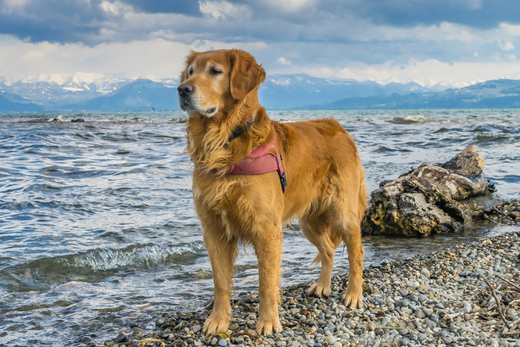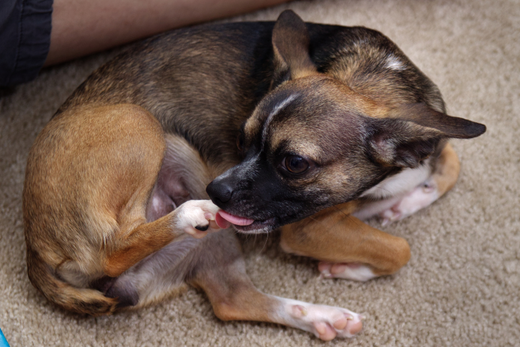Dog hip dysplasia—it's one of those phrases that make any pet lover's stomach drop. It's a common problem in our fluffy pals and dealing with the pain can feel like climbing Everest. But guess what? It's not all doom and gloom! There are tons of things you can do right at home to boost your doggo's happiness levels.
So you've left the vet's office with 'hip dysplasia' ringing in your ears, and you're thinking, "What can I do at home for my poor pup?" Chill out! I've got your six (and your dog's hips). This guide is crammed with handy tips, clever hacks, and useful advice to help both you and your furry family member tackle this head on.
Ever Wonder What The Heck Dog Hip Dysplasia Is?
Alright, let's break it down for ya. It's when the hip joint is throwing a fit and doesn't want to play nice, not slotting together like it should. Instead of cozying up inside the hip socket, the hip bone starts to grind and rub - ouch! This can lead to a grumpy pup with inflammation and, if we ignore it, even arthritis.
No surprise, some breeds like the tough German Shepherds, the lovable Labradors, and the adorable Golden Retrievers are a bit more likely to get hit with this. But stay calm – it doesn't mean your doggo is going anywhere. With a little TLC, they can still wag their tail happily and live their best life.
How Can You Treat Dog Hip Dysplasia At Home?
Are you wondering how you can treat your dog's hip dysplasia at home? I'm here to help! It's as easy as ABC, and your aim is clear - minimize the pain, boost their mobility, and enhance your furry friend's overall happiness. Let's break it down, shall we?
1) First stop, Weight Management.
This one's a serious deal. Maintaining your dog's weight in the healthy zone helps lessen pressure on their hips. If your pooch is somewhat on the fluffier side (No judgment here, Fluffy), it's about time to take a look at their meal plan.
Here's your game plan:
- Time to dish out high-quality, portion-controlled meals.
- Ignore those irresistible puppy dog eyes begging for table scraps.
- Work in some tasty yet healthy, low-cal eats into their routine (like apple slices or carrot sticks).
2) Consistent, Low-Impact Exercise.
Don't get 'regular exercise' mixed up with hardcore sprint sessions. Canine buddies with hip dysplasia require managed, low-impact activities to keep their muscles toned and joints flexible.
Fun routines to test out:
- Easy-peasy leash walks
- Swimming (If your dog's got a hint of mermaid/merman in them, this is perfect!)
- Gentle playtime on non-slip surfaces
Be sure to steer clear of high-impact exercises like ball-catch jumps or sprints on tough surfaces as these can go from fun to ouch real quick, worsening the condition.
3) Supplements for Healthy Joints
Supplements that support joint health are a rad way to keep your dog's hips grooving. Look for options with glucosamine, chondroitin, or omega-3 fatty acids, all superstars at reducing inflammation and boosting joint health.
The fan favorites:
- Fish oil
- Green-lipped mussel powder
- Turmeric (just make sure to ask your vet what's the right dose!)
Turmeric Chews for Dogs
4) Create a Comfortable Home Environment
Soft, supportive surfaces are the bomb when it comes to lessening hip pressure, especially during their regular snooze sessions.
Here's what your fur baby is going to adore:
- A super comfy orthopedic dog bed to give those joints some love
- Slip-free rugs or mats so there's no more slipping and sliding on hard floors
- Ramps or steps because, trust me, they're not giving up on that couch any time soon
5) Massage and Stretching
Who doesn’t love a good massage? And guess what? Your dog will love it too! Gentle massages can relieve muscle tension around the hips, while stretching helps with mobility and flexibility.
Tip: consult with your vet or a canine physical therapist to learn how to perform safe stretches and massages.
6) Over-the-Counter Medications
Prescriptions meds are, of course, a vet thing. But, there are non-prescription options like CBD oil for pets making some noise in the pain relief department. Always, always check in with your vet before trying any new products, even if they're all-natural.
7) Hydrotherapy
Although typically done at a clinic, you can create your own “DIY hydrotherapy” sessions if you’ve got access to a safe swimming pool or a gentle lake. Water exercise reduces joint stress, builds muscle, and helps your dog get their daily workout without pain.
Building a Routine
Here's the scoop: when it comes to managing your pup's hip dysplasia at home, consistency is your BFF. We're talking rigidity, routine, the whole nine yards. I mean, give your dog its meals, exercise, and any treatments you're using, all at the same time every day. Dogs are major fans of predictability (who knew, right?), and a stable as heck schedule will make 'em feel safe and sound.
Need a hand getting started? Check out this sample daily schedule:
- Morning: How about a short, low-impact stroll followed by a drool-worthy breakfast (don’t forget the joint supplements)?
- Midday: Time for a zen-like massage or some therapeutic stretches - feel the burn.
- Evening: Another gentle walk or swimming sesh, dinner time (yum!), and of course, all the cuddles you can give.
When to Holler for Professional Help
Ok, so home treatments can do some serious magic, but there may come a time when you're gonna need a hand from the professionals. Stay alert for these red flags:
- A sudden increase in your doggo's pain or limping
- Their sudden refusal to move or play (total buzzkill)
- Weight loss or changes in eating habits
- Not-so-fun signs of depression or lethargy
If any of these symptoms pop up, it's time to dial up your vet, stat. You guys can reassess your four-legged friend's treatment plan together and maybe even consider additional steps like physical therapy or prescription meds. In more serious cases, surgery could be an option.
How to Keep the Vibes Up
Contending with hip dysplasia can be a real emotional roller coaster—for both your furry friend and you. But just remember, your pup's looking to you for some chill vibes and positive energy. So keep things light-hearted, dish out those belly rubs like they're going out of fashion, and make a fuss over the little victories (like a rocking swim sesh or a particularly happy tail wag during walks).
And hey, when you need a bit of a pep talk, don't be shy to reach out to your fellow dog parents who've been right where you are now. Whether it's in a digital forum, a social media pet-lovers group, or your local doggy daycare, swapping tales and tips can do wonders.
Wrapping Up the Doggy Bag
Sure, managing hip dysplasia at home might mean a bit more elbow grease, but trust me, the reward—watching your best bud's tail go a mile a minute without any pain—is totally worth it. From watching their waistline to trips to the hydrotherapy pool to giving a good massage, there's loads you can do to make sure your four-legged friend stays fit as a fiddle.
Remember to keep your vet in the mix, too! They're your top ally in helping your dog live their best, hippest life.
Just never forget, your dog's put all their trust in you. Together, you guys can take on hip dysplasia and give them all the comfort, care, and cuddles they need.
Now, go ahead, give your pooch some extra belly rubs for me! 🐾
References
1) Schachner ER, Lopez MJ. Diagnosis, prevention, and management of canine hip dysplasia: a review. Vet Med (Auckl). 2015 May 19;6:181-192. doi: 10.2147/VMRR.S53266. PMID: 30101105; PMCID: PMC6070021.




